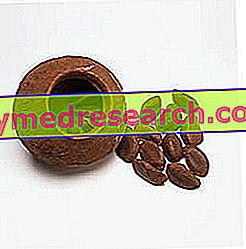What is that
Aconitum napellus - also known as aconite napello, or more simply, aconite - is a perennial herbaceous plant belonging to the Ranuncolaceae family.

Moreover, for several years, the aconite has also been exploited by traditional medicine for the treatment of pains of neuralgic origin.
Currently, the aconite napello is considered as a plant as beautiful as it is toxic and, for this reason, its use in the field of traditional medicine has now been abandoned. However, it still finds several applications in the homeopathic field.
Botany Description
As mentioned, the aconite napello is a perennial herbaceous plant, which can reach a height of between 0.5 and 1.5 meters. The leaves are broad palmatosette, alternate and variously incised. The flowers are pedunculated and blue-violet in color (but there are also other species of aconite whose flowers are yellow).
The hypogean part of the stem, usually, is a fusiform tuberous rhizome and the roots are secondary to the rhizome.
Active principles
Drugs and Chemical Composition of Aconitum napellus
The drug consists of the roots and tubers of the plant, which contain highly toxic active ingredients. In truth, toxic substances are present in all parts of the plant, but in the roots and tubers are found in higher concentrations (0.5-1.9%).
However, the aforementioned toxic principles are polycyclic alkaloids, whose main exponent is represented by aconitine . Alongside this substance, we also find mesaconitine, hypaconitine and oxo-aconitine.
Aconitine is extremely toxic, so much so that the lethal dose for humans is just 3-6 mg, corresponding to about 3-4 grams of fresh tuber.
Did you know that ...
Aconitine has such high toxicity that it is considered the second most active plant poison in the world. The record in this record, on the other hand, is held by nepaline, an alkaloid contained in another species of aconite: the Aconitum ferox of Nepal.
Toxic effects
Toxic Effects and Aconitine Action Mechanism
The toxic effects of the plant take place above all at the level of the heart and of the nervous system, mainly due to aconitine, mesaconitine and hypaconitine, although all the alkaloids of the aconite are toxic.
In detail, aconitine is able to increase the permeability of cell membranes for sodium ions and thus delay their repolarization. Because of this particular mechanism of action, aconitine first exerts a stimulating effect, followed by paralysis of both the peripheral nerve endings and the central nervous system.
As for the toxic effects on the heart, on the other hand, at low doses the aconitina causes bradycardia and hypotension; while at high doses it causes an initial positive inotropic effect, followed by tachycardia and, finally, by cardiac arrest.
Uses and Property
Despite its well-known and marked toxicity, the aconite napello has found, over the years, different fields of application: from that in folk medicine, up to the now abandoned use in traditional medicine, passing through shamanic uses and Religious.
Use in Traditional Medicine
In the past, aconite preparations were used topically in the treatment of rheumatic pains and, above all, of trigeminal neuralgia. In fact, the drug applied to the skin exerts an anesthetic action capable of giving relief from painful stimuli. However, the anesthetic effect of topical aconite preparations is preceded by a burning and tingling sensation, caused by the initial stimulating action exerted by the aconitine itself.
Despite the real effectiveness of this remedy, the risk that toxic principles can be absorbed transcutaneously is concrete. For this reason, the aconite-based preparations were left on the skin only for a short time and, above all, they were never applied in case of damaged skin.
Despite these precautions, given the high toxicity of its active ingredients, the use of the plant in traditional medicine has been gradually abandoned in favor of safer and more effective medicines.
Currently, the only officially approved use of naponon aconite is that in the homeopathic field.
Uses in Homeopathic Medicine

According to the classic principle of "similar care the like", aconite-based homeopathic preparations are indicated in cases of pain of nervous origin, acute inflammatory diseases and heart palpitations associated with anxiety.
Popular Medicine and Other Uses
In folk medicine, the uses of aconite mainly concern the treatment of neuralgic pains, muscular pains and skin inflammations.
In addition to uses in folk medicine, as mentioned, the aconite napello is used in some types of shamanic rituals and over the years has even been used for the preparation of potions and ointments used in magic rituals (elixir of youth, potions of love and aphrodisiac potions, serums of truth, etc.).
Poisoning
Symptoms and Treatment of Aconitum Napellus Poisoning
As repeatedly stated, aconitine intoxication can occur not only by ingestion, but also by transcutaneous injection and at low dosages.
The typical symptoms that occur following poisoning with aconite napello are:
- Tingling sensation in the tongue, lips, face, throat and limbs;
- Sense of anguish;
- Dry mouth;
- Sensation of numbness and cold;
- Myasthenia;
- Dizziness;
- Nausea and diarrhea;
- Cardiac rhythm alteration;
- Cardiorespiratory collapse.
Usually, during the manifestation of these symptoms, the state of consciousness of the poisoned patient is never altered and death occurs due to respiratory arrest.
Unfortunately, at the moment there is no antidote able to counteract Aconitum napellus poisoning. Therefore, the only treatment available in the event of ingestion is immediate evacuation by induced vomiting or gastric lavage. Naturally, the intoxicated patient must be immediately hospitalized, in order to receive all the necessary supportive therapies.
Did you know that ...
Many of the poisonings from Aconitum napellus occur mainly in spring. This is because, in this period, the shoots of the plant are mistakenly collected and consumed since they are confused with the shoots of other types of edible plants, such as the alpine cicerbita ( Lactuca alpina, family of the Asteraceae) and the mountain asparagus ( Aruncus dioicus, Rosaceae family).
For more information: Aconito in Erboristeria



